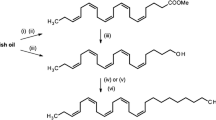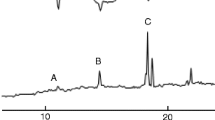Abstract
When physiologically excessive amounts of the female sex pheromone of the European corn borer (ECB) or esters analogous to the pheromone were applied to the antennae of males, their behavioral responsiveness to pheromone in a flight tunnel was significantly impaired for 2 hr. Concurrent quantitative analyses of heptane extracts of the male antennae by gasliquid chromatography showed that the compounds applied to antennae were hydrolyzed and, at 2 and 4 hr posttreatment, little or none of the compound applied or hydrolysis product was detectable in the antennal extracts. After 4 hr of in vivo incubation, male responsiveness to pheromone was restored among moths treated with the analogs but not among moths treated with pheromone. Esterase activity on the antennae was moderately inhibited in vivo by a pheromone analog that is a so-called transition-state esterase inhibitor, 1,1, 1-trifluoro-14-heptadecen-2-one. However, the analog did not inhibit male behavior when it was coevaporated with pheromone in a flight-tunnel assay. Therefore, in the presence of pheromone, the analog did not compete well for esterase or the pheromone receptor. Treating the antennae of intact males with tetrahydrofuran obliterated sex pheromone response capability in males, but the treatment did not significantly attenuate esterase and other catabolic activity of the antennae. Indications are that degradation of esters on the ECB antennae involves substrate-nonspecific esterase activity and other metabolic processes that in turn remove hydrolysis products from the antennae. Maintenance of a male's ability to respond to pheromone is linked to these processes.
Similar content being viewed by others
References
Ferkovich, S.M. 1982. Enzymatic alternation of insect pheromones, pp. 165–186,in D.M. Noms (ed.), Perception of Behavioral Chemicals. Elsevier/North Holland, Amsterdam.
Ferkovich, S.M. Mayer, M.S., Rutter, R.R. 1972. Conversion of the sex pheromone of the cabbage looper.Nature 242:53–55.
Hammock, B.D., Wing, K.D., McLaughlin, J., Lovell, V., andSparks, T.C. 1982. Trifluoromethyl ketones as possible transition state analog inhibitors of juvenile hormone esterase.Pestic. Biochem. Physiol. 17:76–88.
Kasang, G. 1971. Bombykol reception and metabolism on the antennae of the silkwormBombyx mon, pp. 245–250,in G. Ohloff and A.F. Thomas (eds.). Gustation and Olfaction. Academic Press, New York.
Kasang, G., Knauer, B., andBeroza, M. 1974. Uptake of the sex attractant 3H-disparlure by male gypsy moth antennae (Lymantria dispar) (Porthetria dispar).Experientia 30:147–148.
Kasang, G., Von Proff, L., andNicholls, M. 1988. Enzymatic conversion and degradation of sex pheromones in antennae of the male silkworm mothAntheraea polyphemus.Z. Naturforsch. 43:275–284.
Kasang, G., Nicholls, M. andVon Proff, L. 1989. Sex pheromone conversion and degradation in antennae of the silkworm mothBombyx mori L.Experientia 45:81–87.
Klun, J.A., andHuettel, M.D. 1988. Genetic regulation of sex pheromone production and response: Interaction of sympatric pheromonal types of European corn borer,Ostrinia nubilalis (Lepidoptera: Pyralidae).J. Chem. Ecol. 14:2047–2061.
Kochansky, J., Tette, J., Tashenberg, E.F., Cardé, R.T., Kaissling, K.-E., andRoelofs, W.L. 1975. Sex pheromone of the moth,Antheraea polyphemus.J. Insect Physiol. 21:1977–1983.
Mayer, M.S. 1975. Hydrolysis of sex pheromone by the antennae ofTrichoplusia ni.Experientia 31:452–454.
McLean, J. Morgan, B., Sweeney, J.D., andWeiler, L. 1989. Behavior and survival of western spruce budworm,Choristoneura occidentalis Freeman, exposed to an ω-fluorinated pheromone analog.J. Chem. Ecol. 15:91–103.
Prestwich, G.D. 1987. Chemical studies of pheromone reception and catabolism, pp. 473–527,in G.D. Prestwich and G.J. Blomquist (eds.). Pheromone Biochemistry. Academic Press, Orlando, Florida.
Prestwich, G.D., andStreinz, L. 1988. Haloacetate analogs of pheromones: Effects on catabolism and electrophysiology inPlutella xylostella.J. Chem. Ecol. 14:1003–1021.
Prestwich, G.D., Vogt, R.G., andRiddiford, L.M. 1986. Binding and hydrolysis of radiolabeled pheromone and several analogs by male-specific antennal proteins of the moth pheromoneAntheraea polyphemus.J. Chem. Ecol. 12:323–333.
Prestwich, G.D., Graham, S.M., andKoenig, W.A. 1989. Enantioselective opening of the (+)− and (−)-disparlure by epoxide hydrolase in gypsy moth antennae.J. Chem. Soc, Chem. Commun. 1989:575–577.
Prestwich, G.D., Graham, S.M., Kuo, J.-W., andVogt, R.G. 1990. Tritium-labeled enantiomers of disparlure. Synthesis and in vitro metabolism.J. Am. Chem. Soc. 111:636–642.
SAS Institute, 1988. SAS Users Guide: Release 6.03. SAS Institute Inc., Cary, North Carolina.
Schwarz, M., Klun, J.A., Fritz, G.L., Uebel, E.C., andRaina, A.K. 1989. European corn borer sex pheromone: Structure-activity relationships.J. Chem. Ecol. 15:601–617.
Schwarz, M., Klun, J.A., andUebel, E.C. 1990. European corn borer sex pheromone inhibition and elicitation of behavioral response by analogs.J. Chem. Ecol. 16:1591–1604.
Shaw, D.A., andTuominen, T.C. 1985. An efficient synthesis of 3-hydroxy-3-trifiuoromefhylphthalide.Synth. Commun. 15:1291–1297.
Tasayco, M.L., andPrestwich, G.D. 1990. Aldehyde-oxidizing enzymes in an adult moth: In vitro study of aldehyde metabolism inHeliothis virescens.Arch. Biochem. Biophys. 278:444–451.
Taylor, T.R., Ferkovich, S.M., andVan Essen, F. 1981. Increased pheromone catabolism by antennal esterases after adult eclosion of the cabbage looper moth.Experientia 37:729–731.
Vogt, R.G., andRiddiford, L.M. 1986. Scale esterase: A pheromone-degrading enzyme from scales of silk mothAntheraea polyphemus.J. Chem. Ecol. 12:469–482.
Vogt, R.G., Riddiford, L.M., andPrestwich, G.D. 1985. Kinetic properties of a sex phero-mone-degrading enzyme: The sensillar esterase ofAntheraea polyphemus.Proc. Natl. Acad. Sci., U.S.A. 82:8827–8831.
Author information
Authors and Affiliations
Rights and permissions
About this article
Cite this article
Klun, J.A., Schwarz, M. & Uebel, E.G. European corn borer: Pheromonal catabolism and behavioral response to sex pheromone. J Chem Ecol 17, 317–334 (1991). https://doi.org/10.1007/BF00994335
Received:
Accepted:
Issue Date:
DOI: https://doi.org/10.1007/BF00994335




